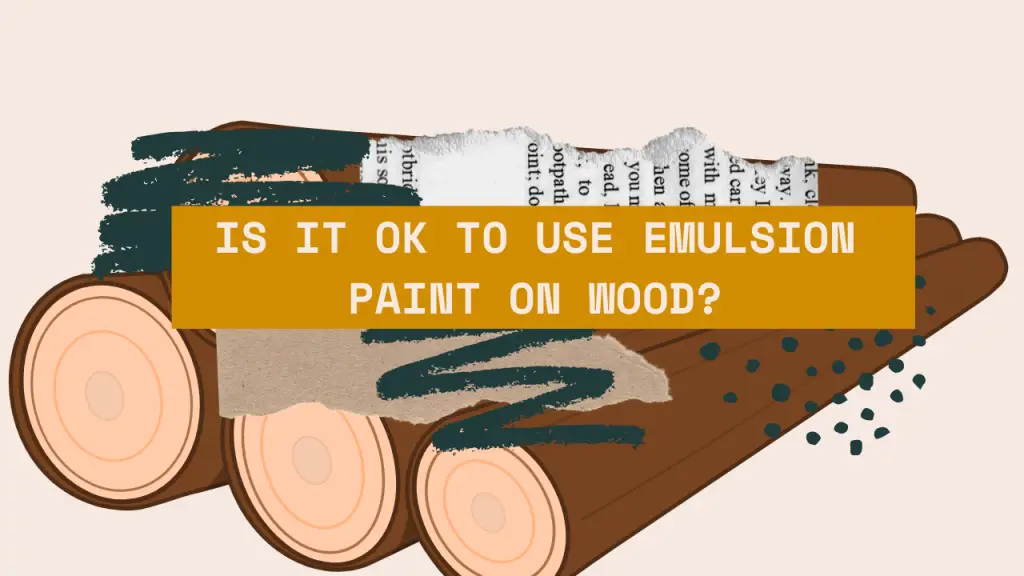Are you considering using emulsion paint on wood but are unsure if it is the right choice? This article will provide you with all the information you need to make an informed decision.
Is it ok to use emulsion paint on wood? Yes, it is generally acceptable to use emulsion paint on wood surfaces. Emulsion paint provides good coverage and adhesion to wood, creating a smooth and durable finish. Ensure the wood is properly prepared and primed before applying emulsion paint for optimal results.
Emulsion paint is suitable for interior woodwork, but for exterior wooden surfaces, it’s crucial to use exterior wood treatment for enhanced durability and weather resistance. Properly preparing the wood surface before painting is essential for achieving the best results.
Emulsion paint offers several advantages when used on wood surfaces, such as its versatility, ease of application, and wide range of color options.
However, there are also some disadvantages to be aware of, including its durability and potential for peeling or cracking.
By understanding the advantages and disadvantages, as well as considering alternative options, you can determine if using emulsion paint on wood is suitable for your specific project.
Advantages of Using Emulsion Paint on Wood
You’ll be amazed at the stunning, smooth finish and vibrant colors you can achieve when using emulsion paint on wood!
One of the main benefits of using emulsion paint on wood is its versatility. Emulsion paint is commonly used on walls, but it can also be applied to wood surfaces with great success. This means that you can easily transform your wooden furniture, doors, or even wooden walls with a fresh coat of emulsion paint.
Another advantage of using emulsion paint on wood is its ease of application. Emulsion paint is water-based, which makes it easy to work with and clean up. Unlike oil-based paints, emulsion paint dries quickly and has a low odor. This means that you can enjoy a hassle-free painting experience without worrying about strong fumes or long drying times.
Additionally, emulsion paint is available in a wide range of vibrant colors, allowing you to customize and brighten up your wooden surfaces according to your preferences. Whether you want a bold and vibrant look or a more subtle and muted finish, emulsion paint offers endless possibilities for enhancing the beauty of your wood.
Disadvantages of Using Emulsion Paint on Wood
There are several drawbacks to using emulsion paint when it comes to painting wooden surfaces. One major concern is the cost implications. Emulsion paint is generally more expensive compared to other types of paint that are specifically designed for wood. This means that using emulsion paint on wood can significantly increase the cost of your painting project.
If you are on a tight budget or looking for a more cost-effective option, it might be wise to consider alternative paints that are more suitable for wooden surfaces.
Another disadvantage of using emulsion paint on wood is durability. Emulsion paint is not as durable as other types of paint that are formulated for wood. This means that over time, the paint may start to chip, peel, or fade, especially in high-traffic areas or when exposed to harsh weather conditions.
Additionally, emulsion paint may not provide the same level of protection against moisture or other environmental factors that can damage wood. Therefore, if you are looking for a long-lasting and durable finish on your wooden surfaces, it is recommended to use paint specifically designed for wood rather than emulsion paint.
Considerations for Painting Wood
When it comes to painting wooden surfaces, it’s important to take into account various factors to ensure a successful and long-lasting finish.
One of the key considerations is preparing the wood for painting. Before applying any paint, it’s crucial to clean the wood thoroughly and remove any dirt, grease, or old paint. Sanding the surface is also essential to creating a smooth and even base for the paint to adhere to.
Additionally, filling any cracks or holes with wood filler will help to achieve a seamless finish. By properly preparing the wood, you can ensure that the paint will adhere well and provide a durable and attractive result.
Another important factor to consider when painting wood is choosing the right type of paint. While emulsion paint can be used on wood, it may not be the best choice in all situations. Emulsion paint is primarily designed for use on walls and may not provide the necessary protection and durability for wood surfaces.
Instead, it’s recommended to use a paint specifically formulated for wood, such as acrylic or oil-based paint. These types of paint are designed to withstand the elements and provide a long-lasting finish on wood.
By choosing the right type of paint, you can ensure that your painted wood surfaces will not only look great but also stand up to the test of time.
Alternative Options for Painting Wood
If you’re looking to explore alternative methods for enhancing the appearance of wooden surfaces, consider trying out different finishes or stains.
Wood staining techniques can be a great option for adding color and depth to your wood. Stains come in a variety of shades and can be applied with a brush or rag, allowing you to achieve the desired look. They penetrate the wood fibers, highlighting the natural grain and texture. Stains are also available in different levels of opacity, so you can choose between a more transparent or opaque finish depending on your preference.
Another option to consider is spray painting wood surfaces. This method provides a smooth and even application, resulting in a professional-looking finish. Spray paints come in a wide range of colors and finishes, giving you endless possibilities for transforming your wooden pieces. Just make sure to choose a spray paint specifically formulated for wood to ensure long-lasting results.
Whether you opt for wood staining techniques or spray painting, both options offer a versatile and effective way to enhance the appearance of your wooden surfaces.
Summary of the advantages, disadvantages, and alternatives for using emulsion paint on wood
To achieve a stunning and durable finish on your wooden surfaces, consider exploring the advantages, disadvantages, and alternatives of using emulsion paint. Emulsion paint is a popular choice for many because of its ease of use and availability in a wide range of colors.
One of the main advantages of using emulsion paint on wood is its ability to provide a smooth and even finish. It can hide imperfections on the surface of the wood and create a polished look. Additionally, emulsion paint is relatively quick to dry, allowing for multiple coats to be applied in a shorter period.
However, it’s important to note that emulsion paint may not be suitable for all wooden surfaces. It tends to work best on interior woodwork, such as skirting boards or furniture, rather than on exterior surfaces. This is because emulsion paint is not as durable as other types of paint when exposed to harsh weather conditions.
Another disadvantage is that emulsion paint may not adhere well to certain types of wood, such as oily or resinous wood. In such cases, it’s advisable to use a primer or a different type of paint specifically formulated for wood.
Considering these pros and cons, it’s worth exploring alternative options for painting wood, such as oil-based or acrylic-based paints, which may offer better durability and adhesion on different surfaces.
Conclusion
In conclusion, is it ok to use emulsion paint on wood? Using emulsion paint on wood can have its advantages and disadvantages.
On the positive side, emulsion paint is easy to apply, dries quickly, and provides a smooth and even finish. It also comes in a wide range of colors, allowing for creative expression in wood projects.
However, there are some drawbacks to consider. Emulsion paint may not be as durable as other types of paint, and it may not provide adequate protection against moisture and UV rays. Additionally, it may not adhere well to certain types of wood surfaces, requiring extra preparation work.
When deciding whether to use emulsion paint on wood, it’s important to consider the specific needs of the project. If durability and long-term protection are a priority, it may be worth considering alternative options such as oil-based or acrylic paints. These types of paints offer superior resistance to moisture, UV damage, and wear and tear.
It’s also important to properly prepare the wood surface before painting, ensuring good adhesion and a longer-lasting finish. Ultimately, the choice between emulsion paint and other options will depend on the desired aesthetic, level of protection, and the specific characteristics of the wood being painted.










